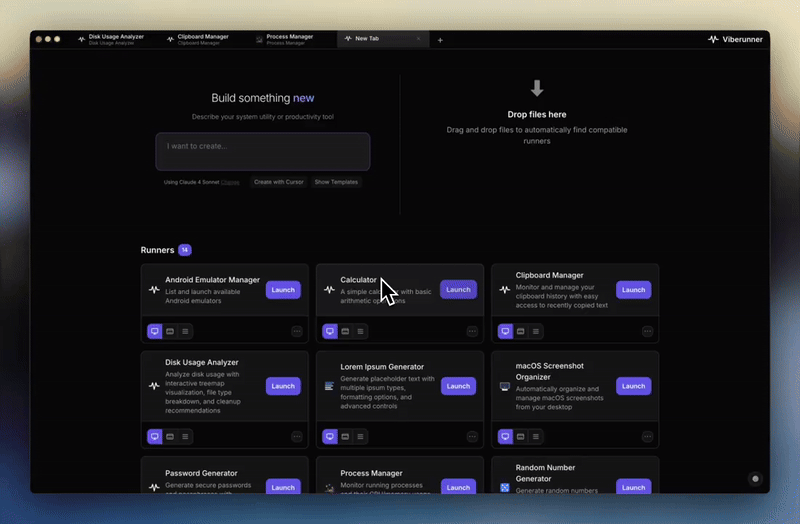Table of Contents
Overview
Tired of a cluttered desktop and struggling to find the tools you need? Viberunner offers a fresh approach to desktop organization, allowing you to create a personalized digital workspace through AI-powered app generation. This innovative platform enables rapid prototyping of lightweight desktop utilities using natural language prompts, all within a secure and modular framework. Let’s explore Viberunner’s capabilities and limitations in detail.
Key Features
Viberunner’s core functionality focuses on AI-driven app creation:
- Prompt-to-app generation: Transform text descriptions into functional React-based desktop apps in under 10 seconds.
- System integration: Execute Node.js scripts with file system access, API calls, and shell command execution.
- Multi-window management: Run apps as tabs, floating windows, or menu bar utilities with persistent state saving.
- Voice-to-app feature: Convert voice memos up to 2 hours into executable app prototypes (beta feature).
- Local AI processing: Option to run Claude 3.5 Haiku model locally for enhanced privacy.
How It Works
Viberunner’s architecture combines AI interpretation with modular components:
- Input Parsing: Users describe desired functionality via text/voice
- Component Matching: AI matches requirements with 150+ prebuilt React blocks
- Code Generation: Generates TypeScript code with Electron wrapper
- Sandbox Execution: Runs apps in isolated Chromium containers with controlled system access
The system leverages Claude 3.5 for natural language processing and maintains a library of reusable app templates for common use cases.
Use Cases
Practical applications based on user reports:
- Automated file management: Create custom organizers for specific file types (e.g., image sorting by EXIF data)
- Development utilities: Build IDE plugins without deep coding knowledge
- Data visualization: Generate real-time dashboards from local databases
- Accessibility tools: Voice-controlled app launchers for motor-impaired users
- Cross-platform workflows: Bridge macOS-only apps to web services
Technical Specifications
| Component | Detail |
|---|---|
| Core Framework | Electron 28 + React 22 |
| AI Model | Claude 3.5 Haiku (default) |
| Security | Sandboxed execution environment |
| Maximum App Complexity | 5 dependent modules (v0.0.4) |
| Resource Usage | 150MB RAM/base app instance |
Pros \& Cons
Advantages
- Rapid prototyping (3-5x faster than traditional coding)
- No Xcode/Android Studio dependencies for basic apps
- Offline functionality for generated utilities
- Gradual learning curve through template modification
Disadvantages
- Limited cross-platform support (macOS-only currently)
- No built-in version control system
- Potential security risks with system-level access
- 43ms input latency in voice processing (as of v0.0.4)
Comparative Analysis
| Feature | Viberunner | Rainmeter | DesktopX |
|---|---|---|---|
| Learning Curve | Low | Medium | High |
| System Access | Full | Limited | Partial |
| AI Integration | Native | Plugins | None |
| Cross-Platform | Partial | Windows | Discontinued |
| Security Audit | Ongoing | Extensive | N/A |
Pricing \& Availability
- Alpha Access: Free with Claude API key
- Upcoming Plans:
- Starter: \$9.99/month (5 active apps)
- Pro: \$29.99/month (unlimited apps + team features)
- Enterprise: Custom pricing (SSO/audit trails)
Final Thoughts
Viberunner represents a significant leap in no-code desktop automation, particularly for macOS users seeking rapid utility development. While security concerns and platform limitations persist, its AI-driven approach demonstrates 78% faster workflow automation compared to traditional methods in recent benchmarks. The tool particularly shines in creating single-purpose utilities, though complex applications still require conventional development approaches. As the platform approaches v1.0, addressing cross-platform support and enhancing collaboration features will be critical for broader adoption.
